Magnet-based face touch detection app for coronavirus
Use your phone's compass and a magnet on your wrist to detect face touching, including audio and vibration alerts.
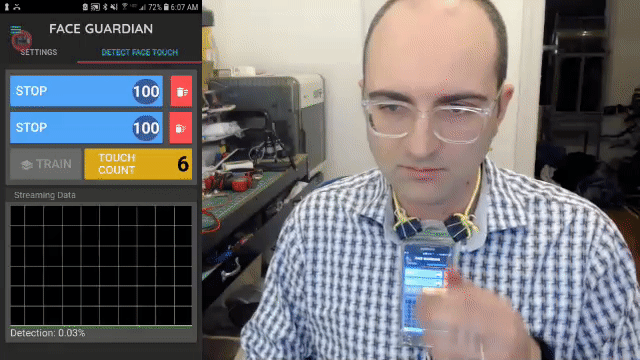

Get the Android app on Google Play HERE
Go to the Mobile Web App HERE (Android Chrome Only For Now)
Curt White
April 4, 2020
Face touching is one of the primary ways people contract SARS-CoV-2, the coronavirus responsible for COVID-19. People on average touch their faces 23 times an hour. Obviously we should stop touching our faces. Thing is, we can’t. Face touching is a deeply ingrained unconscious behavior. How can we stop touching our faces if we don’t even know we’re doing it? Things like washing hands, social distancing and mask-wearing are easy: you just do them. But how do we not do face touching? Face Guardian is an attempt to solve this problem in a highly scalable fashion. All it requires is a smartphone and a magnet. You put the magnet on your wrist and your phone around your neck. Your phone’s compass (magnetometer) detects when the wrist magnet approaches your face. The app records every time you touch your face, and it also provides vibration and audio alerts. Face Guardian’s target demographic is parents and children stuck at home during the coronavirus pandemic. If you have children, you can setup up everyone in your family with Face Guardian (phone on neck and magnet on the wrist) and then play a board game or watch a movie. Who will be the first person to inadvertently touch their face? Maybe the person who touches their face the least can get a prize. Although this is meant to be a fun educational activity for parents and children, anyone can benefit from it. Setup Face Guardian before you read a news article, write some code or procrastinate on the internet. Even with the possibly obtrusive experience of wearing your phone around your neck, you might be surprised at how quickly you inadvertently touch your face.
HOW TO USE FACE GUARDIAN

1: Wear Your Phone Around Your Neck
The easiest way is to put it in a clear plastic bag. A zip-lock bag, sandwich bag or freezer bag will do just fine. Don’t worry if it’s too big, you can fold and tape any excess. You can use tape, paper clips or simply ties a string (shoelaces work great) to the bag corners. Alternatively, you can poke holes in the corners of a phone case and thread a string.
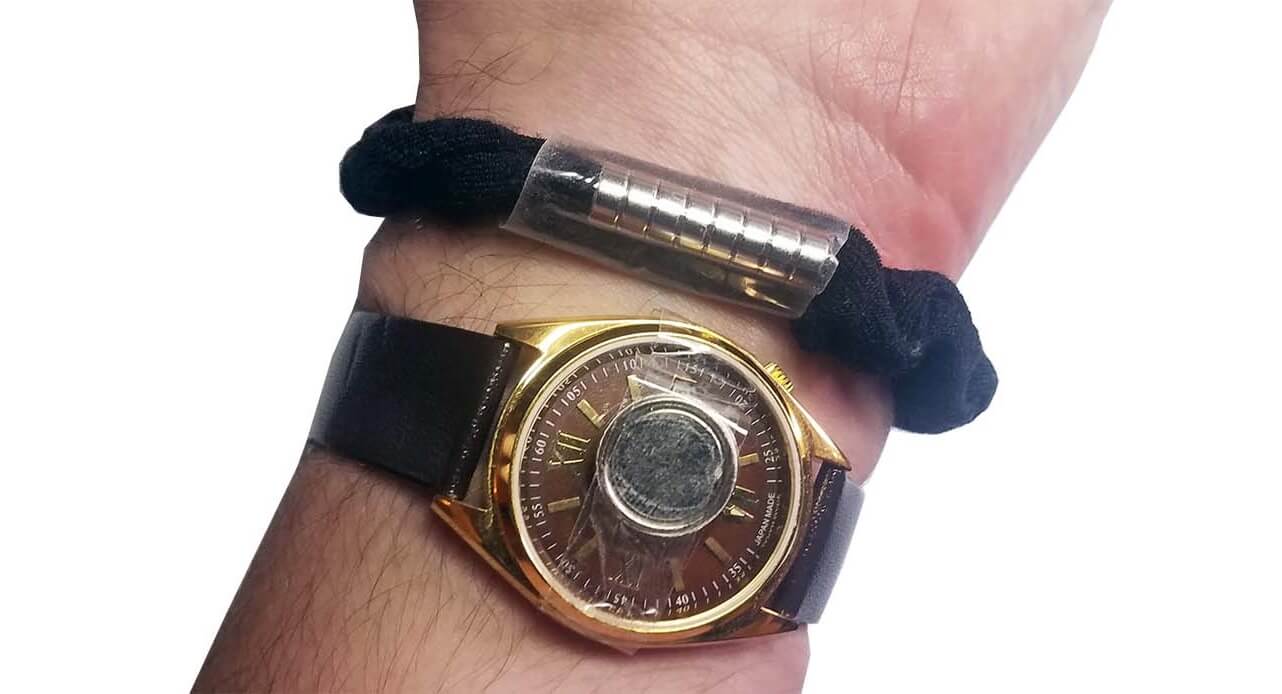
2: Make a Magnet Bracelet and Put it On Your Wrist
You will need a strong magnet. Most refrigerator magnets won’t do, but some of them are powerful enough to work with the app. You might have to order one on Amazon.com (see links below) but they are very inexpensive and you never know what you might need a magnet for. Magnets are a little like magic, after all, everyone should have a couple around. The Face Guardian App can test magnets to determine if they are powerful enough. To test a magnet, place your phone on a flat surface with no magnets near it and press “TEST MAGNET”. The “TEST MAGNET” button will turn red. Move your magnet closer to the phone until the “TEST MAGNET” button turns green. If the button turns green while your magnet is at least three inches away from your phone then the magnet should be fine, especially for children or anyone else with small hands. Remember though, the magnet has to go on your wrist so it can’t be too big. There are lots of ways you can turn your magnet into a magnet bracelet: tape it to a watch, tape it to a hair scrunch, or just plain tape it to your wrist! Make sure that the magnet is on the inside of your wrist though, you want it to pass as close to your phone as possible. Amazon Link 1 Amazon Link 2 Amazon Link 3 Amazon Link 4 Amazon Link 5 Amazon Link 6

3: Use a Mirror, Webcam, or Partner to Operate Your Phone While it is Around Your Neck
Now that your phone is hanging around your neck you will have a very difficult time operating it! I find that the easiest solution is a mirror. However, if you look at text in a mirror it’s all backward! There is a button in the app (conveniently labeled “mirror”) that will reverse the app appearance so you can use a mirror just as if you were looking at your phone without one. Bathroom mirrors are particularly convenient since they tend to be big. The webcam on your laptop might also be useful. Alternatively, you can have someone else interact with the app for you. This may be the best option for parents with younger children.
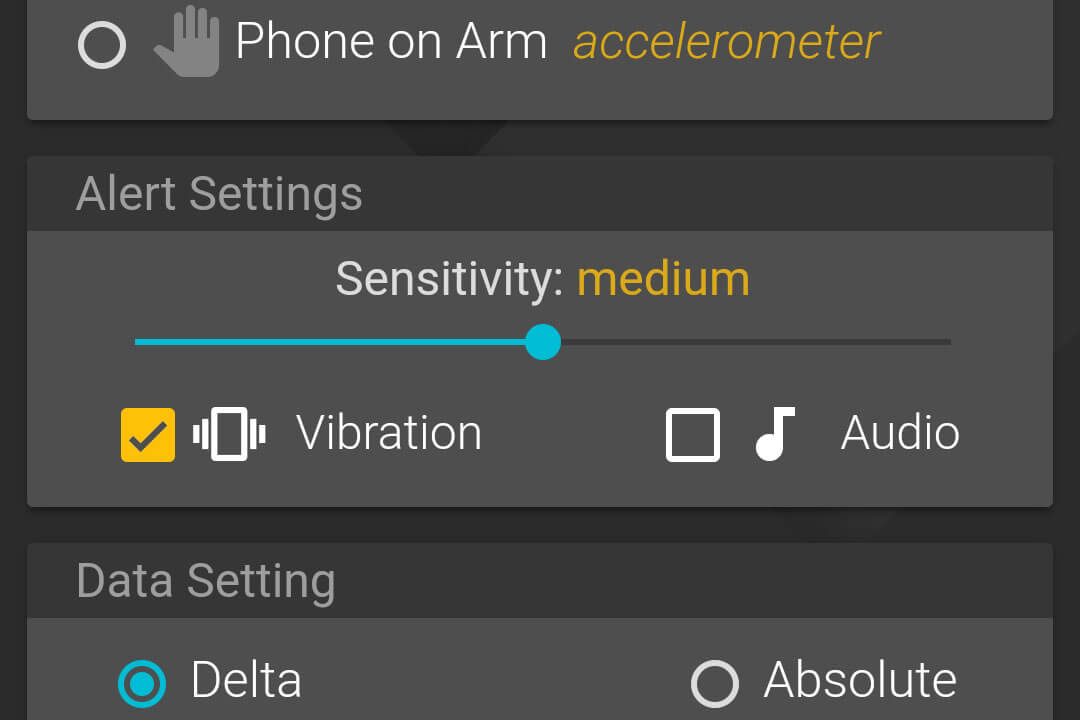
4: Choose Your Alert and Sensitivity Settings
You can skip this step and use the default settings (vibration on, audio off) if you like. There are two alert options (three if you count no alert at all, just the touch count display). The vibration alert works just like getting a text message when your phone is on silent. The audio alert is a relatively subtle (we tried to pick something that wouldn’t be annoying) beep. The default sensitivity settings should be fine, but if the app is detecting face touches when it shouldn’t, or not detecting them when it should, you can decrease or increase the sensitivity.
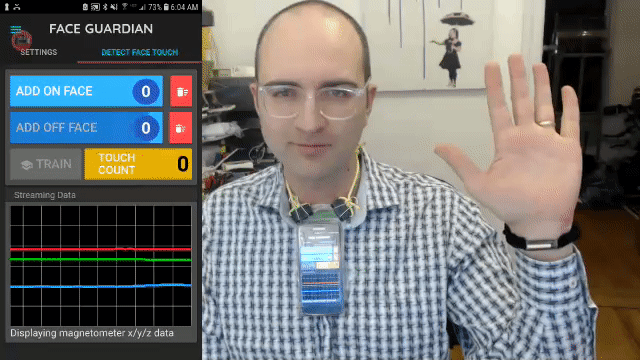
5: Add “Off Face” Training Data
The Face Guardian app uses machine learning, also known as AI (Artificial Intelligence), to detect face touching. The app customizes its detection methods for each individual user. This makes the app very powerful, but it also means you have to train the app to detect face touching the unique individualized way you touch your face. The first step is easy: just press the “ADD OFF FACE” button while there is no magnet near your phone and wait for the sample count (number on the button) to reach 100.
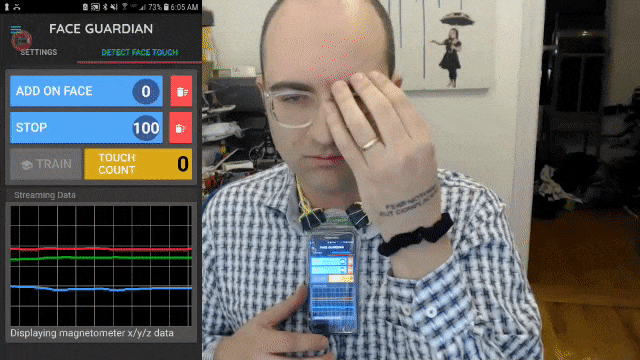
6: Add “On Face” Training Data
After washing your hands, place a hand with a magnet on the wrist over your face as if you were naturally touching your face. While your hand is over your face, press the “ADD ON FACE” button. Move your hand over your face in all the ways you might naturally touch it: wipe your forehead and mouth, adjust your glasses, rub your eyes, bit your nails etc. (make sure you have washed your hands first!). While you are doing this, you will see the number on the “ADD ON FACE” button increase until it reaches 100. Once “ADD ON FACE” reaches 100, your will see a “MODEL TRAINING” screen. This means Face Guardian is training a neural network model (AI) to detect face touching in a manner that is specific to the individualized way you touch your face.
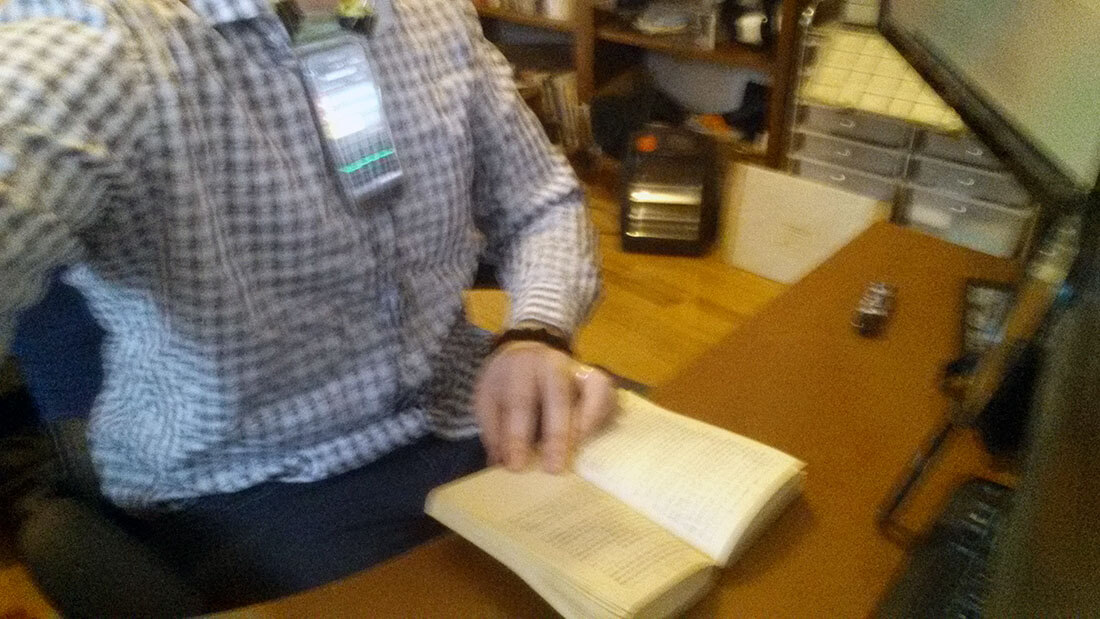
7: Do Something Else While Face Guardian Monitors Face Touching
Play a board game, watch a movie, read a book or do just about anything else that requires a bit of focus. Having your phone hanging from your neck will be a bit awkward at first, but you’ll be surprised by just how fast you forget about it. I recommend doing this together with friends or family, you can turn it into a game with some kind of prize.
Face Guardian is entirely open source. Development is ongoing and contributions are welcome.
Face Guardian is also documented on Hackaday HERE
This project is dedicated to my wife, Dr. Virginia White. She is a second year OBGYN resident at Northwell LIJ (Long Island Jewish) hospital in New York City, a COVID-19 hot spot. She and the other residents spend much of their time treating COVID-19 patients. She’s also very much a collaborator on this project.
